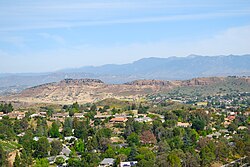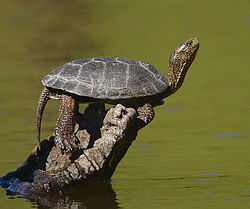Wildwood Regional Park
| Wildwood Regional Park | |
|---|---|
 Little Falls waterfall. | |
 | |
| Type | Regional park |
| Location | Simi Hills and Conejo Valley, Ventura County, California |
| Coordinates | 34°13′15″N 118°54′40″W / 34.22083°N 118.91111°W |
| Area | 1,765 acres (7.14 km2) |
| Created | 1967 |
| Operated by | Conejo Open Space Conservation Agency (COSCA) |
| Status | Open |
Wildwood Regional Park is a suburban regional park in the western Simi Hills and Conejo Valley, in Ventura County, California. It is located in western Thousand Oaks, northern Newbury Park, and southern Moorpark.
Wildwood is home to over 27 miles of hiking trails. The four principle trails are the Mesa-, Moonridge-, Wildwood Canyon- and Santa Rosa Trails. Over 250 plant species have been recorded in Wildwood, as well as 37 species of mammals, 70 bird species, and 22 species of amphibians and reptiles.[1]
The park consists of 1,765 acres (7.14 km2), and is connected to adjacent open-space areas comprising an additional 1,400 acres (5.7 km2).[2] The park is operated by the Conejo Open Space Conservation Agency (COSCA).


History
The area was home to the
Sheep and cattle grazed the area for much of the 19th- and early 20th century. It was also used as a
The park was created in 1967 when the Conejo Recreation and Park District (CRPD) acquired Mount Clef Ridge and Wildwood Canyon from the Janss Investment Company land developers. It was merged with Wildwood Mesa Park in 1987 and is now administrated and operated by the Conejo Open Space Conservation Agency (COSCA), which is a joint organization by the Conejo Recreation and Park District (CRPD) and the City of Thousand Oaks.[9]
Restrictions were put in place for Paradise Falls during the COVID-19 pandemic due to crowded conditions in which people were unable to social distance and also the resulting litter and human waste that was left behind.[9]
Features

The park offers recreational outdoor activities, including hiking, mountain biking, jogging, horseback riding, picnicking, educational tours, interpretive programs, camping, and wildlife viewing.
Some of the popular attractions in the park include the 70 feet (21 m) cascade of Paradise Falls,[11][12] as well as the Arroyo Conejo Creek and creek-bed, the large wooden teepee, the Nature Center and Indian Cave.[13] The Lizard Rock formation is a serrate volcanic outcropping in the Mount Clef Ridge.[14]
At Lizard Rock, Teepee Overlook, and similar higher elevation areas, there are panoramic views of the Conejo Valley.
Attractions
Points of interest include:[15]
- Arroyo Conejo: Creek, creekbed, and gorge.
- Paradise Falls: year-round 70-ft. cascade in a steep gorge.
- Little Falls: one of two year-round waterfalls.
- Lizard Rock: serrate volcanic outcropping resembling a lizard.
- Spartacus, Wuthering Heights, and others.[16]
- Indian Cave
- Nature Center (Meadows Cave)
- Teepee Overlook: large wooden teepee on a knoll.
- Fort Wildwood: log fort located at the opening of the park near Avenida De Los Arboles and Lynn Road. The fort has long been removed and a trail marker put in its place.
Trails
The park is home to 14 nature trails covering over 27 miles.[17]
Among the most popular hiking trails are the 2.5 mile Mesa Trail Loop, 3 mile Lizard Rock Trail, 3 mile Moonridge Trail, 3 mile Paradise Falls Trail, 3 mile Indian Creek Loop, 4 mile Wildwood Park Loop, 6 mile Lower Butte Trail Loop, 6 mile Lynnmere Trail, 6.3 mile Santa Rosa Trail (going to the hills by California Lutheran University), 6.5 mile Santa Rosa Loop, and the 7 mile Hill Canyon Trail.[18]
For the main park entrance, from the Lynn Road exit on the 101 Freeway (Ventura Freeway) and take Lynn Road northbound for 2.5 miles to Avenida de Los Arboles. Then turn left and continue for 0.9 miles to the end of the street at Big Sky Drive.[19] There are numerous other trailheads, including: by 398 Briar Bluff Court, 2601 San Miguel Circle, 930 Lynnmere Drive, and 2629 Velarde Drive in Thousand Oaks; by 11121 Rocky High Road in Santa Rosa Valley; by 11160 Sumac Lane in Camarillo, as well as in Newbury Park on the west and Moorpark in Box Canyon.

Ecology
Wildwood Regional Park is recognized for its varied terrain,
The climate is Mediterranean, but oftentimes cooler than other areas in the Conejo Valley due to cool coastal breeze easily winding its way up through canyons and lower elevations.[20]
The park's flora is extensive and more than 250 plant species have been recorded within the park.
.Wildlife

The park is home to a wide variety of
It is home to various mammals, such as the plentiful
The most common amphibians here are found along the Arroyo Conejo creekbed, and include the ensatina, slender salamander, western toad, American bullfrog, California toad, Pacific tree frog, and the California red-legged frog.
There are a variety of reptiles − including
There are a variety of songbirds, wood-peckers, and raptors such as
Mammals
Wildwood Regional Park is home to 37 species of mammals, including:[24]
- Gray fox
- Cougar
- Bobcat
- Red fox
- Ring-tailed cat
- Mule deer
- Valley coyote
- Virginia opossum
- California raccoon
- American badger
- Long-tailed weasel
- Striped skunk
- Spotted skunk
- Black-tailed jackrabbit
- Desert cottontail
- Brush rabbit
- Western gray squirrel
- Fox squirrel
- California ground squirrel
- Merriam's chipmunk
- Botta's pocket gopher
- Desert shrew
- Ornate shrew
- Broad-footed mole
- California vole
Reptiles and amphibians
- Southern Pacific rattlesnake
- Pacific gopher snake
- California kingsnake
- Ringneck snake
- Two-striped garter snake
- Red coachwhip
- California whipsnake
- California black-headed snake
- Western yellow-bellied racer
- San Diego mountain kingsnake
- Southwestern threadsnake
- Coast patch-nosed snake
- San Diego nightsnake
- California lyre snake
- California glossy snake
- Pacific pond turtle
- Red-eared slider
- American bullfrog
- Pacific treefrog
- California treefrog
- California toad
- Western spadefoot toad
- California red-legged frog
- Black-bellied slender salamander
- California newt
- Monterey salamander
- Arboreal salamander
- Southern alligator lizard
- Great Basin fence lizard
- Western skink
- Western side-blotched lizard
- Coastal whiptail
- Blainville's horned lizard
- California legless lizard
Filmography
The park sits in the Thirty Mile Zone, an area sufficiently close to Hollywood that studios do not have to pay extra for on-location shooting. A nearby road, Flaming Star Avenue, is named after the film Flaming Star (1960) starring Elvis Presley, which was filmed in the area.[25] The park is still occasionally used for filming.[26] Some of the many films shot here include:[27]
- Welcome to Hard Times[32]
- Wuthering Heights[33][34][35]
- The Rifleman (1958-63)[38][39][40][41][42][43]
- The Grapes of Wrath[46][47]
- Riders of the Whistling Pines[48][49]
- The Ballad of Josie[50]
- Bonanza[51][52][53]
- Duel in the Sun[66][67]
- The Big Valley (1965-69)[68][69]
- Clearing the Range[70]
- Flaming Frontier[71][72]
- The Horse Soldiers[73]
- Flaming Star[74][75]
- Lassie Come Home[76][77][78]
- To the Shores of Iwo Jima[79][80]
- The Guns of Will Sonnett (1967-69)[81]
- The Gay Ranchero[82][83]
- Gunsight Ridge[84][85]
- The Ride Back[86]
- Westward Ho the Wagons![87][88][89]
- The Left Handed Gun[90][91]
- Wild Heritage[92]
- Escort West[93]
- The Man Who Shot Liberty Valance[94][95][96]
- Advance to the Rear[97]
- Stage to Thunder Rock[98]
- Shenandoah[99][100]
- The Plainsman[101][102]
- Dark Victory[105]
- The Outsider[106]
- Firecreek[107][108]
- Ride a Crooked Trail
- Rawhide[109]
- Cheyenne Autumn[110]
- The Young Country
- The Concentratin' Kid
- Tales of Wells Fargo
- Sands of Iwo Jima
- He Rides Tall
- Cattle Town
- Bad Boy (1949)
- Taggart(1964)
- The Legend of Tom Dooley
- Tall Man Riding
- Rebel in Town
- The Doolins of Oklahoma
- Cast a Long Shadow
- Apache Rifles
- The First Texan
- The Lawless Breed
- Death of a Gunfighter
- Red Sundown
- Man Without a Star
- Cimarron (1960)
- Journey to Shiloh
- The Duel at Silver Creek
- The Bull of the West
- Destry(1954)
- The Good Guys and the Bad Guys
- The Command (1954)
- Man of the West
See also
- Arroyo Conejo Nature Preserve)
- Mount Clef Ridge
- Hill Canyon
- Conejo Canyons Open Space
- Natural history of the California chaparral and woodlands
- Parks in Ventura County, California
- Simi Hills topics
References
- ^ Maxwell, Thomas J. (2000). Hiking In Wildwood Regional Park: Natural History, Folklore, and Trail Guide. California Lutheran University. Pages 2-4.
- ISBN 9781479165599.
- ISBN 9781564131867.
- ^ Maxwell, Thomas J. (1982). The Temescals of Arroyo Conejo. California Lutheran College. Page 93.
- ^ Maxwell, Thomas J. (1982). The Temescals of Arroyo Conejo. California Lutheran College. Pages 21-22.
- ISBN 9780934161534.
- ISBN 9780899976396.
- ISBN 9780897327077.
- ^ a b Money, Luke (2020-05-28). "Record crowds trash Ventura County waterfall with litter, human waste". Los Angeles Times. Retrieved 2020-05-28.
- ISBN 9781439661956.
- ^ Chang, Jade (July 24, 2020). "The 5 best hiking trails in L.A. with waterfalls". Time Out Los Angeles. Retrieved 2020-08-04.
- ISBN 9781612381633.
- ISBN 9781573420624.
- ISBN 9781573420198.
- ^ Maxwell, Thomas J. (2000). Hiking In Wildwood Regional Park: Natural History, Folklore, and Trail Guide. California Lutheran University. Page 4.
- ISBN 9781429907170.
- ISBN 9781573420624.
- ISBN 9780899973517.
- ISBN 9780964673779.
- ISBN 9781479165599.
- ISBN 9780762768189.
- ISBN 9781439624999.
- ISBN 9780899976273.
- ^ Maxwell, Thomas J. (2000). Hiking In Wildwood Regional Park: Natural History, Folklore, and Trail Guide. California Lutheran University. Page 3.
- ISBN 9780897812993.
- ISBN 9780897327077.
- user-generated source]
- ISBN 9781439624999.
- ISBN 9781429907170.
- ISBN 9781493017959.
- ISBN 9780897327077.
- ISBN 9780692561348.
- ISBN 9780934161534.
- ISBN 9781439624999.
- ^ Maxwell, Thomas J. (2000). Hiking In Wildwood Regional Park: Natural History, Folklore, and Trail Guide. California Lutheran University. Page 2.
- ISBN 9780934161534.
- ISBN 9780899976396.
- ^ Maxwell, Thomas J. (2000). Hiking In Wildwood Regional Park: Natural History, Folklore, and Trail Guide. California Lutheran University. Page 2.
- ISBN 9780934161534.
- ISBN 9781573420624.
- ISBN 9781439624999.
- ISBN 9780899973517.
- ISBN 9780899976273.
- ISBN 9780692561348.
- ISBN 9781476604329.
- ISBN 9780899976396.
- ISBN 9780897327077.
- ISBN 9781476604329.
- ISBN 9781430309680.
- ISBN 9780692561348.
- ISBN 9780899976396.
- ISBN 9781573420624.
- ^ Maxwell, Thomas J. (2000). Hiking In Wildwood Regional Park: Natural History, Folklore, and Trail Guide. California Lutheran University. Page 2.
- ISBN 9780738580395.
- ISBN 9781573420624.
- ISBN 9780899976396.
- ^ Maxwell, Thomas J. (2000). Hiking In Wildwood Regional Park: Natural History, Folklore, and Trail Guide. California Lutheran University. Page 2.
- ISBN 9780899973517.
- ISBN 9780899976273.
- ISBN 9781493017959.
- ISBN 9781573420624.
- ISBN 9780738580395.
- ^ Maxwell, Thomas J. (2000). Hiking In Wildwood Regional Park: Natural History, Folklore, and Trail Guide. California Lutheran University. Page 2.
- ISBN 9780899973517.
- ISBN 9780899976273.
- ISBN 9780899976396.
- ISBN 9780897327077.
- ISBN 9780899976396.
- ISBN 9781429907170.
- ISBN 9780899976396.
- ISBN 9780899976396.
- ISBN 9781476604329.
- ISBN 9780899976396.
- ISBN 9780897812993.
- ISBN 9780899976396.
- ISBN 9781429907170.
- ^ "Festival spotlights classic films shot in T.O." 7 November 2013.
- ISBN 9780897812993.
- ISBN 9780897812993.
- ISBN 9781476604329.
- ISBN 9780897812993.
- ISBN 9780692561348.
- ISBN 9781476604329.
- ISBN 9780692561348.
- ISBN 9781476604329.
- ISBN 9780692561348.
- ISBN 9781429907170.
- ISBN 9780692561348.
- ISBN 9781476604329.
- ISBN 9780692561348.
- ISBN 9781429907170.
- ISBN 9780692561348.
- ISBN 9780692561348.
- ISBN 9780692561348.
- ISBN 9781476604329.
- ISBN 9781429907170.
- ISBN 9780692561348.
- ISBN 9780692561348.
- ISBN 9780692561348.
- ISBN 9781476604329.
- ISBN 9780692561348.
- ISBN 9781476604329.
- ^ "Locally filmed Westerns 'Butch Cassidy,' 'Gunsmoke' part of Conejo film fest".
- ^ "Conejo film fest highlights Westerns". 12 November 2015.
- ISBN 9781429907170.
- ISBN 9781429907170.
- ISBN 9780692561348.
- ISBN 9781429907170.
- ISBN 9781429907170.
- ISBN 9781429907170.
